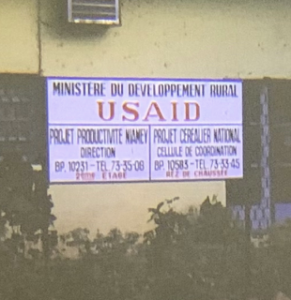by Mark G. Wentling
US missions are required to prepare Integrated Country Strategies (ICS) every three years. In addition, missions with USAID programs are required to prepare Country Development Cooperation Strategies (CDSS) every five years. In developing countries, the strategies usually focus on increasing food crops and nutritional levels.
I found during fifty years of work in a dozen missions that few read these strategies and even fewer apply them in their work. Missions go through a stressful period of completing these documents, but once Washington approves them they are often forgotten in a flurry of competing action requirements. Missions are usually engaged with applying the latest U.S. policy or assistance directives. And work priorities and budgetary allocations can shift dramatically with the installation of a new US administration.

It is also possible that the strategies are ignored because they often do a poor job of dealing with issues related to food security, which should be a primary aim of assistance programs in developing countries. The reasons for this may be two-fold. First, the plans need to be comprehensive enough to cover the major issues that affect food security. Second, they need then to identify the key components within each country that a development program may be able to impact successfully. The formulation of effective food, agricultural, and nutrition strategies should cover at least five broad, but inter-related components:
- agricultural productivity/nutrition;
- trade/markets;
- natural resource environment;
- food aid; and
- policy/advocacy.
Fleshing out these five components requires contending with a complexity of related factors, while staying up to date with a rapidly changing world. These are among the primary issues that need to be considered and addressed:
Agricultural Productivity and Improved Nutrition
• Falling soil fertility must be addressed in a country dependent upon agricultural production.
• Climate change and demography affect food security scenarios.
• Inadequate nutritional levels will hinder other development efforts.
Trade and Markets
• Durable poverty reduction requires functioning markets.
• To be competitive in the marketplace, smallholders must be able do a simple business plan.
• Policies that increase the cost of imported food may incentivize local food production.
• Crop diversification and growth for export are needed for a healthy agricultural sector.

Natural Resource Environment
• Sound environmental and conservation practices are needed to preserve soils and the livelihoods of future generations.
• Note that green revolutions require special soil, water and climatic conditions.
• Careful orchestration of progressive land redistribution and resettlement programs, and the division of land use between farmers and pastoralists, are needed to increase food production, avoid conflicts and preserve natural resources.
• Excessive corruption and low institutional capacities and literacy levels compromise the achievement of sustainable livelihoods and the preservation of natural resources.
Food Aid Costs and Complicating Factors
• Local factors are important, but international ones (e.g., Ukraine war) need to be considered.
• Poor infrastructure and the landlocked position of many countries add to costs.
• Rapid urbanization, rural out-migration, increases in refugees and internally displaced persons pose special challenges.
• High crime and insecurity increase costs and delivery obstacles.
Policy and Advocacy
• Job creation is needed to raise the standard of living and is the ultimate litmus test of development.
• The absence of secure land tenure and reliance on hand tools are signs of an underdeveloped agriculture system.
• Sustainable agricultural development requires: peace and stability; full participation of women; reliable and affordable electricity; and adequate safety nets.
This list, however comprehensive, may need modification or addition for the particular country concerned. For example, are there local cultural values that aspects of a development plan might violate?
An effective plan must not only consider a broad range of factors, but it must also identify the key constraints in a particular country that an assistance program can address. Let me provide a couple of examples, one unsuccessful and one successful.

I started work for USAID in Niger in 1977. For my first five years, I was the American manager of a complex integrated rural development project. We assisted in every sector in a specified geographic region. Other donors did the same in other regions. The best and brightest Nigerien and American employees were engaged. The support of the host government and local communities was generous. Our funding was unlimited. Today, any trace left by this successful project is gone. This project ended years later by achieving nothing sustainable because it required a level of financial, intellectual, and technical inputs that the host country did not have the capacity to sustain over the long run.

Years later, in the mid-1990s, I experienced a hugely successful project in Tanzania that involved building roads to open up areas that had high agricultural potential. It was amazing to see trucks full of agricultural produce and inputs moving along these farm-to-market roads. Even more impressive was the host government’s decision to sustain this project by adding a fuel tax to continue the funding of the construction of rural access roads by private sector companies. The host government successfully identified a key constraint, addressed it, and provided the resource underpinning necessary to ensure that it continued to be addressed. Today, it is rare for USAID to fund rural infrastructure projects, no matter how justifiable they are.
As these two examples illustrate, it can be difficult to predict a project’s success. Often, this is due to factors extraneous to the project itself. A robust project should, to the extent possible, provide margins for factors such as changing assistance priorities in Washington and budgetary delays. A mission strategic plan also needs to deal honestly with the capabilities of the host government. It is not possible to achieve developmental progress in a fragile, failing, or failed state. In such cases, the emphasis needs to be on humanitarian assistance and scarce development resources should be used elsewhere.
To conclude, while there is no magic bullet for predicting developmental success, a comprehensive mission strategic plan that identifies the key, country-specific factors inhibiting progress can become a useful, rather than neglected tool around which to build more effective assistance programs.![]()

Mark G. Wentling retired in 1996 from the Senior Foreign Service after serving as USAID’s principal officer in six African countries. His 50 years in Africa includes work with the Peace Corps, nongovernmental organizations, and as a contract employee for USAID. He has published nine books, including an African Trilogy and his three-volume Africa Memoir, which covers all 54 Africa countries, as well as numerous professional articles. In August 2022, his ninth book, Kansas Kaleidoscope, was published. In 2023, he plans to publish his tenth book, Jackleg Boys. He resides in Lubbock, Texas with his Ethiopian wife and one of his seven grown children. He claims to have been born and raised in Kansas but made in Africa.
